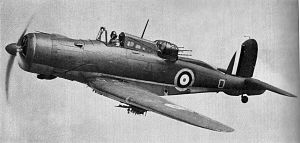| B-25 Roc | |
|---|---|
 | |
| General information | |
| Type | Carrier-based fighter |
| Manufacturer | Boulton Paul |
| Designer | |
| Primary user | Royal Navy |
| Number built | 136[1] |
| History | |
| Introduction date | April 1939 |
| First flight | 23 December 1938 |
| Retired | 1943 |
| Developed from | Blackburn Skua |
The Blackburn Roc (company designation B-25) was a naval fighter aircraft designed and produced by the British aviation company Blackburn Aircraft. It took its name from the mythical bird of the tales of the Arabian Nights, the Roc. It was operated by the Fleet Air Arm (FAA) and was active during the Second World War.
The Roc was designed to Air Ministry Specification O.30/35 and was derived from the Blackburn Skua dive-bomber/fighter and developed in parallel to it. Unlike the Skua, the Roc had its armament in a turret. A large proportion of the work was subcontracted to another aircraft manufacturer, Boulton Paul, which had also designed their own turret fighter, the Boulton Paul Defiant. On 23 December 1938, the prototype Roc performed its maiden flight. Testing soon revealed it to have a relatively low maximum speed of only 223 mph (194 kn; 359 km/h). The float plane version of the Roc was even slower, leading to the cancellation of plans to equip float plane squadrons with the type. Cancellation of the project was discussed but this move was dismissed largely due to the wider impact on aircraft production.
During April 1939, the conventional version of the Roc was brought into FAA service. The type was present during the Allied campaign in Norway, as well as Operation Dynamo and Operation Aerial, the evacuations of Allied forces from Dunkirk and other French ports. The Roc quickly came to be viewed as inferior to existing aircraft, such as the Skua and the type had only a limited career in front-line service. The Roc's sole confirmed aerial victory occurred on 28 May 1940, when a patrolling Roc of 806 Naval Air Squadron, flown by pilot Midshipman A. G. Day, shot down a Junkers Ju 88 bomber from below. Towards the end of 1940, the Roc was largely relegated to air sea rescue and target-towing duties. Only sporadic engagements occurred after this point, with no substantial accomplishments occurring. The Roc was withdrawn during 1943.
- ^ Jackson 1968, p. 417.